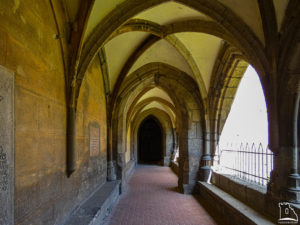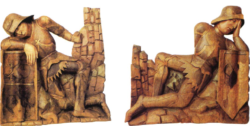Garamszentbenedek
Garamszentbenedek (Hronský Beňadik, Sankt Benedikt) is a village in Upper lands/Horná Zem/Felvidék, it is in Slovakia. It is in the Besztercebánya (Banská Bystrica) District, on the right bank of the Garam river, 120 km north-east of Pozsony (Bratislava, Pressburg). Here is a short video about it: https://www.youtube.com/watch?v=olQiHtWooUU

It was the Hungarian King Géza I who established a Benedictine abbey in 1075 and it was first mentioned in 1124 as e “Monasterium Ecclesia Sancti Benedicti” and in 1366 as “Zent Beneduk”, “Zenthbenedyk”. It was one of the most significant abbeys of the Benedictine Order in Hungary. The abbey had its first seal in 1232.

The building is the nicest example of the early Gothic style in Central Europe. Its towers are 48 meters high. The abbey was rebuilt in the Gothic style during the 14th century. We know that its abbot was called Siegfried who was there between 1330-1355 and later became the Abbot of Pannonhalma.

The buildings of the abbey were in bad condition and the monks received permission to sell indulgence letters to raise money for the construction. This way the place has been repaired and fortified by 1407.

The stronghold was taken by the troops of Selmecbánya (Banská Štiavnica, Schemnitz)town in 1428 but later they gave it back to the monks. The Hussite mercenaries of the Czech Jan Giskra besieged the abbey and the captain called Csalkai Máté ceded the fort to him. Fortunately, Lord Hunyadi János was able to take the abbey back in the same year.

In the abbey, there is the Chapel of the Holy Blood which was built in 1489. Here is the gift of Pope Paul II that he gave to King Matthias Corvinus, a piece from the veil of Saint Veronica. Széchy János became the abbot in 1473 and rebuilt the walls of the abbey by 1507. He got the roof finished around 1510.

As it was well-fortified, the men of King Szapolyai János defended it against the soldiers of King Ferdinand I. Later, the troops of the Habsburg king took it easily in 1530, led by Turn Miklós. The period of the Dual Kingship tore the country in two.

According to the Church, the abbey belonged to Várdai Pál, the Archbishop of Esztergom in 1536 but gradually it became a fort. The abbey joined the local alliance that worked together to defend the northern Mining Towns in 1537. The village or small town paid taxes after six houses in 1535 but it had 91 houses in 1601. The Czudar family had a stately home there and it could boast a pub, a school, and a mill, and the Horvay family had a palace there as well.
The first guild was established in 1659 and three more were born until 1718, and 93 houses paid taxes in 1715. Gradually, its military function became the most important and we could find no monks only soldiers in the abbey by 1542. When the Ottoman Empire was pushing its boundaries further to the north, Garamszentbenedek became part of the chain of Borderland castles of Hungary but there were just very few soldiers in it.

At the Ottomans` campaign in 1552, the abbey was in great peril again but despite this, only 15 soldiers were paid in it. As a result of this, the Turks could take it from time to time for shorter periods and they even destroyed it in 1559 but the Christians rebuilt it later.

We know that there were 40-50 Christian soldiers in it in 1580. The mining towns didn`t want to hire more soldiers so the abbey had to sell its precious goblets in 1588 to raise funds for its defense. They could pay for minor repairs to the wall in the early 17th century from these funds. The abbey was taken by the men of Prince Bethlen Gábor in 1623. During the anti-Habsburg wars, it remained in the king`s hand and its walls are quite intact now.

Lord Koháry István and his family are buried in the church. This hero lost his life in the Siege of Léva in 1664. He was leading the vanguard of General Jean-Louis Raduit de Souches`s army and received a shot at the beginning of the siege. De Souche also died during the taking of Léva castle from the Ottomans.

The king placed a garrison in Garamszentbenedek between 1703 and 1709 against the rebelling “kuruc” Hungarians. Today, many pilgrims are visiting the place.

Dear Readers, I can only make this content available through small donations or by selling my books or T-shirts:
Please, feel free to support me with a coffee here:
You can check out my books "33 Castles, Battles, Legends" and "The Ring of Kékkő Castle" on Amazon or Draft2Digital, they are available in hardcover, paperback, or ebook: https://www.amazon.com/dp/198020490X or at https://books2read.com/b/boYd81
 My work can also be followed and supported on Patreon: Become a Patron!http://Become a Patron!
My work can also be followed and supported on Patreon: Become a Patron!http://Become a Patron!


https://hungarianottomanwars.myspreadshop.com/all








































































































